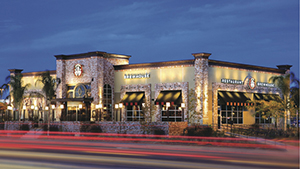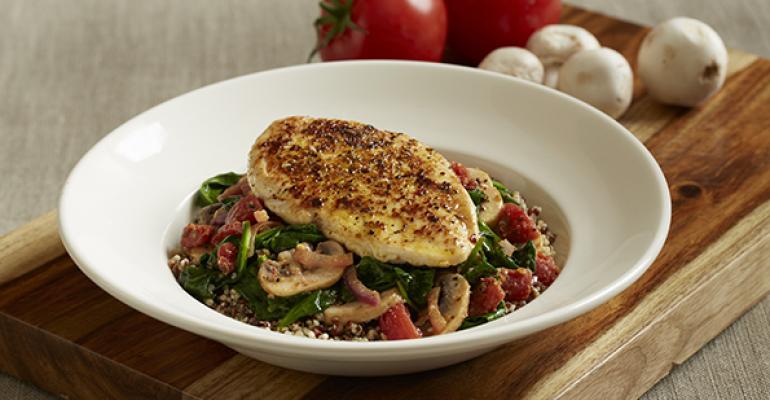After several years of struggling with negative sales trends, BJ’s Restaurants Inc. is gaining traction with initiatives that focus on the basics: better food and more efficient operations.
BJ’s turnaround has had fits and starts, but officials said results are settling into a positive trajectory as efforts over the past 18 months solidify the brand’s positioning as an affordable, polished-casual concept with broad appeal.
Greg Trojan, president and CEO of Huntington Beach, Calif.-based BJ’s, who joined the company in late 2012, told Nation’s Restaurant News that the biggest change has been a simple focus on improving food quality, although he gave some credit to the popularity of Brussels sprouts, formerly a hard sell among consumers.
Brussels sprouts appear in a number of new dishes: fried and dipped in Sriracha crema as an appetizer; roasted as a side dish with Lemon Thyme Chicken; and tucked into a baby kale salad with blueberries, goat cheese and candied pecans. It’s a superfood ingredient that Millennials love and that has defied naysayers on BJ’s board who predicted it wouldn’t play in Peoria.
“Brussels sprout farmers across America should be thanking BJ’s,” Trojan said. “We’re selling a lot of Brussels spouts.”
 Brussels sprouts are just one of the items BJ’s had had success with. The chain has also been beefing up its EnLIGHTened menu line of lower-calorie, healthful options.
Brussels sprouts are just one of the items BJ’s had had success with. The chain has also been beefing up its EnLIGHTened menu line of lower-calorie, healthful options.
New dishes include Fire-Roasted Barbacoa Chicken breast, served over brown rice with black beans and topped with feta, cilantro, crema and salsa. Oven-roasted mahi mahi is topped with sautéed shrimp, red onion, tomatoes, Kalamata olives and garlic over couscous. Roasted salmon and vegetables are drizzled with soy-ginger sauce over quinoa.
Sales from the EnLIGHTened platform grew 25 percent in June, and one in three customers now order from that section of the menu, Trojan said.
That’s not to say BJ’s is skimping on indulgent offerings.
In July, the chain added new Loaded Burgers, including the best-selling Hickory Brisket and Bacon Burger, along with a Peanut Butter and Jelly Pizookie, a signature dessert of a warm cookie base and ice cream.
The premium additions offered a barbell counterbalance to menu changes in 2013 that included value items priced under $10, such as the Brewhouse Burger line, starting at $6.95.
BJ’s took a hit to margins on those value items, but Trojan said they were necessary to drive traffic during an “investment phase” for the brand.
At the same time, the company streamlined its menu, from a peak of about 184 items to around 139, which has reduced kitchen complexity and helped reduce costs, contributing to margin improvements and allowing the brand to focus on execution.
The move was a return, in a way, to BJ’s roots.
BJ’s was founded as a deep-dish pizza concept in 1978, but was reinvented by Paul Motenko and Jerry Hennessy, who took it over in 1991. In 1996, the chain, which then had six restaurants, added a brewery and introduced handcrafted beer. BJ’s also went public that year and began to grow.
Like many casual-dining concepts at the time, however, BJ’s began expanding its menu beyond pizza in an attempt to eliminate the veto vote. A menu that started with about 100 items nearly doubled in size.
As the menu grew, so did the restaurant footprint. Locations added roughly 1,000 square feet, reaching 8,500 square feet. That was another aspect Trojan thought could be reigned in.
Now BJ’s is moving forward with a 7,400-square-foot prototype that is closer to those of its early years. The prototype costs about $1 million less to build but is showing the same sales volumes of similarly situated, larger restaurants in the same market, Trojan said.
“It’s one of the few times in life when you can spend less money and end up with a better outcome,” he said.
The new model includes design upgrades that Trojan described as “upscale, but a little more relaxed.”
“We want folks to come off the softball field and not think twice about stopping at BJ’s, or families to feel comfortable bringing their kids,” Trojan said. “We cast a wide net.”
Broad appeal is BJ’s strength, he said.
“We’re drawing people from all walks of life,” Trojan said. “I love walking the dining room floors in our restaurants. I’m amazed by the diversity of our guests.”
That diversity, however, has made the job more difficult for Kevin Mayer, BJ’s executive vice president and chief marketing officer, who joined the company last year after years of working in marketing for various car brands.
Rather than develop one message to appeal to all, BJ’s is taking a more targeted approach to marketing by attempting to reach guests based on the various reasons they go out to eat.
In a marketing campaign this year dubbed “Craft Matters,” food quality and value are recurring themes, Mayer said. But the message is spliced differently for the 21-year-old working on his fantasy draft picks at BJ’s, compared with the red-hat-wearing senior ladies who lunch.
One digital effort has focused on beer geeks who come to BJ’s for craft beer.
For families, the “craft” theme focused on people who have crafts, including the overbearing parent who doesn’t understand that their 5th grader is supposed to build the derby car.
Outpacing casual dining
With a marketing spend holding flat at slightly above 2 percent of sales, that budget will grow as BJ’s grows.
For the second quarter ended June 30, BJ’s reported an increase in net income of 55.4 percent, to $12.4 million, with record restaurant-level operating margins of 20.9 percent.
Same-store sales increased a modest 0.5 percent for the quarter, although traffic was slightly negative. The dip was blamed largely on a nine-day period during the quarter when the Mayweather-Pacquiao boxing match kept guests at home, along with comparisons with positive traffic generated from last year’s World Cup.
Moving past those comparisons, July same-store sales were tracking positive, in the 1.5-percent range, and guests continued to respond positively to the chain’s reworked menu, Trojan said.
In fact, BJ’s same-store sales results outpaced the casual-dining industry as a whole during several months recently, and again in July, said Malcolm Knapp, who tracks casual-dining trends with the Knapp-Track Index.
Year-to-date, casual-dining same-store sales have risen 1.7 percent, although traffic remains a drag, declining 1.2 percent, he said.
BJ’s guest counts, meanwhile, rose 0.7 percent in the third quarter of 2014, increased 1.7 percent in the fourth quarter, and grew 1.6 percent in the first quarter this year, before dipping slightly in the latest quarter, company officials said.
Knapp predicted those trends would remain strong for BJ’s as improvement efforts continue to pay off.
“BJ’s momentum is very good right now. The initiatives they’re putting in place are bearing fruit,” Knapp said. “They’ve done all the right things to effect change and deliver a better customer experience.”
This year, BJ’s is scheduled to open 16 restaurants, one more than originally projected. Officials have committed to a double-digit growth rate.
The chain currently has 166 units in 23 states, and Trojan sees the opportunity to grow to as many as 425 locations across the U.S.
BJ’s turnaround has been achieved under the shadow of activist investors, some of whom joined the board in 2014. Earlier this month, however, Luxor Capital Group began cutting its stake in BJ’s, which could indicate a general sense that their work with the company is done.
If anything, the activists brought a sense of urgency to the table, Trojan said.
“You don’t wake up as CEO saying, ‘I hope an activist calls me tomorrow,’ but I have to give our partners credit for helping us get to where we’ve gotten,” Trojan said. “We fundamentally agreed with the platform and point of view those investors brought. We shared a common agenda, and they’ve been very helpful with resources.”
As BJ’s generates more cash than it is using, it has flexibility to grow and buy back stock. It’s a good situation to be in, Trojan said.
As consumers return to casual dining, BJ’s is well positioned to take advantage. If for nothing else, Trojan expects it will all come down to the food.
“I find it interesting how many mature restaurant companies lose sight of food quality,” he said. “That’s not something we ever intend to do. You need great food and great service, but without consistently great food, people are going to find someplace else to eat.”
Contact Lisa Jennings at [email protected].
Follow her on Twitter: @livetodineout




